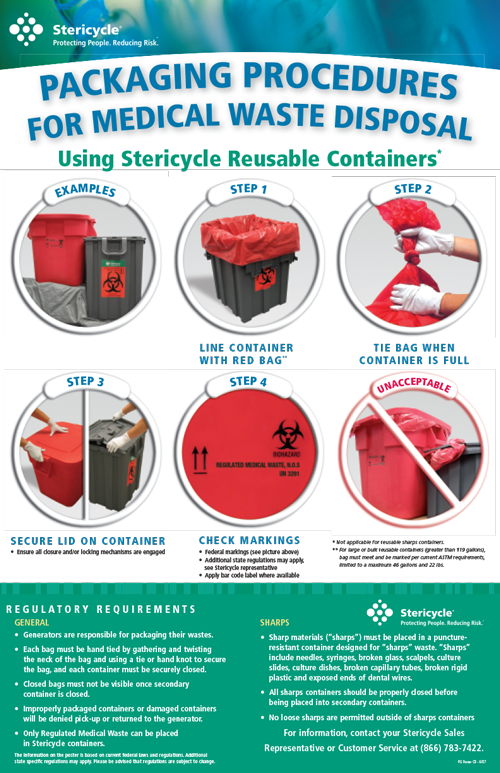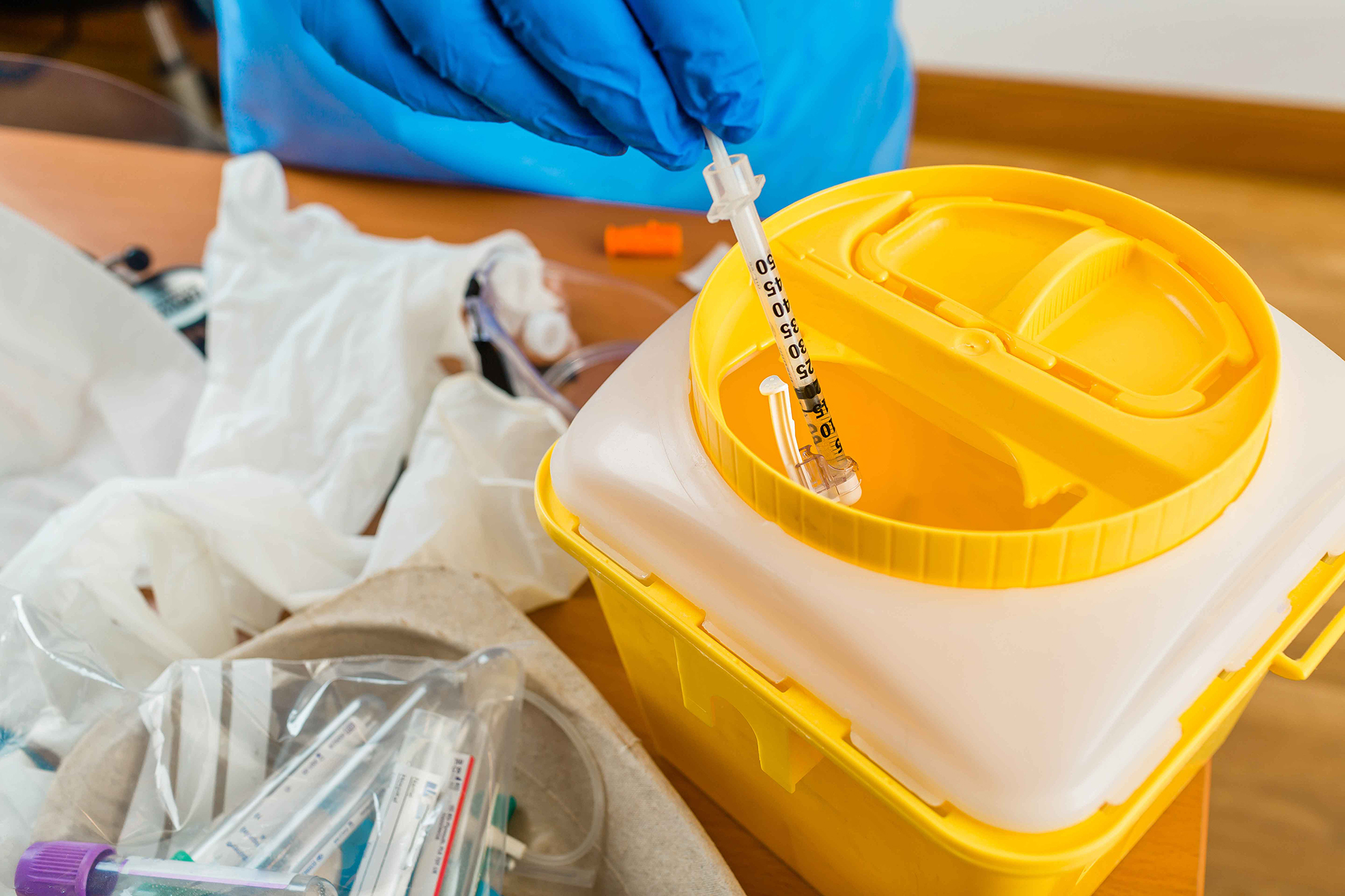Certified and Reliable Medical Waste Removal Service: Partnering for a Cleanser Future
Wiki Article
Efficient Techniques of Medical Waste Disposal
Efficient approaches of medical waste disposal are important in preserving public health and wellness and ecological safety. Medical waste, including sharps, pathological waste, and pharmaceutical waste, should be taken care of and thrown away correctly to avoid the spread of infections and protect the environment. This needs adherence to stringent guidelines and the execution of specialist waste monitoring techniques.Proper partition of clinical waste, secure and safe storage, effective treatment and sanitation techniques, and environmentally-friendly disposal choices are crucial parts of an efficient medical waste disposal system. Expert waste management services play an essential function in making certain conformity with guidelines and decreasing the threats linked with inappropriate disposal. By employing these methods, health care centers can add to a more secure and cleaner setting while safeguarding the health of the neighborhood.
Proper Partition of Clinical Waste
Appropriate segregation of clinical waste is vital for guaranteeing the reliable and secure disposal of these potentially unsafe products. Medical waste describes any type of waste created during healthcare tasks, such as health centers, facilities, research laboratories, and research centers. It consists of a vast array of products, such as made use of needles, syringes, polluted dressings, ended or extra medicines, and organic materials.By segregating clinical waste, health care centers can lessen the risk of infections, injuries, and ecological contamination. The procedure involves categorizing waste right into different types, such as sharps, infectious waste, pharmaceutical waste, and non-hazardous waste. Each kind needs specific handling, product packaging, and disposal methods to avoid direct exposure to medical care employees, waste administration employees, and the general public.
To ensure correct segregation, health care centers ought to create clear guidelines and supply adequate training to team member. This includes enlightening employees on the different waste categories, proper product packaging techniques, and making use of proper containers - WasteX Medical Waste Disposal. Furthermore, clear signs and color-coding systems can be executed to promote the identification and partition of different waste kinds
Safe and Secure Storage Space of Medical Waste
Safe and protected storage space of medical waste is critical for keeping the honesty and control of potentially dangerous materials. Appropriate storage space not just shields medical care workers and the public from direct exposure to hazardous compounds yet additionally protects against ecological contamination.To guarantee risk-free storage, medical facilities should stick to details standards. To start with, waste needs to be saved in puncture-resistant and watertight containers that are classified properly. These containers need to be securely secured to protect against any type of leakage or spills. Additionally, the storage location need to be safe and inaccessible to unapproved workers, reducing the risk of unintentional direct exposure.
Appropriate partition of clinical waste is likewise vital for safe storage space. Various types of waste, such as sharps, transmittable materials, and pharmaceutical waste, need to be separated to prevent cross-contamination. This partition can be achieved via the usage of color-coded containers or containers.
Regular tracking and inspection of the storage space location are crucial to recognize any type of prospective threats or breaches. This consists of checking for indications of damages or degeneration in the containers, ensuring correct ventilation, and monitoring temperature level and humidity degrees.
Reliable Treatment and Sanitation Approaches

One frequently made use of therapy approach is autoclaving, which entails subjecting the waste learn this here now to high-pressure steam at temperatures above 121 degrees Celsius. This process successfully kills bacteria and damages transmittable representatives, making the waste risk-free for additional disposal. An additional approach is incineration, which involves shedding the waste at high temperatures. Incineration not only eliminates microorganisms but also lowers the waste volume with combustion.
Chemical disinfection is another effective approach for dealing with clinical waste. This method entails making use of anti-bacterials such as chlorine substances, phenolic substances, or hydrogen peroxide to kill or suspend microorganisms (WasteX Medical Waste Disposal). Chemical sanitation is often made use of for liquid waste, such as lab examples or bodily fluids
In recent times, alternative therapy techniques such as microwave sanitation, irradiation, and biological therapy have also acquired focus. These methods use advantages such as reduced ecological impact and energy intake compared to standard methods.
Environmentally-friendly Disposal Options
In the realm of clinical waste disposal, considering environmentally-friendly alternatives is vital. Health care facilities produce a substantial quantity of waste, consisting of infectious products, pharmaceuticals, and chemicals, which can present major threats to human wellness and the environment otherwise managed effectively. Luckily, there are numerous environmentally-friendly disposal choices readily available that can assist minimize these dangers.
Reusing clinical waste entails setting apart and refining certain products for reuse or repurposing. In addition, some medical care centers have actually implemented recycling programs for certain medical gadgets or devices, additional lowering waste generation.
This method entails converting medical waste into power via procedures like incineration or anaerobic digestion. Anaerobic digestion, on the various other hand, breaks down natural waste in the absence of oxygen, creating biogas that can be used for electricity or warmth generation.

Advantages of Professional Waste Monitoring Solutions
One significant benefit of expert waste administration services is the boosted efficiency in managing and getting rid of of clinical waste. By making use of professional waste management services, health care facilities can make sure that all clinical waste is taken care of and disposed of properly, minimizing the danger of contamination and the spread of diseases.Expert waste monitoring solutions use experienced and experienced personnel who are educated about the laws and standards for medical waste disposal. They have accessibility to specialized equipment and tools that enable them to manage various sorts of clinical waste securely and successfully. These services likewise have reputable procedures and protocols in location to ensure that waste is segregated, packaged, moved, and disposed of in compliance with neighborhood, state, and government guidelines.
Additionally, expert waste monitoring solutions can give healthcare centers with comprehensive waste administration services. They can use services such as waste collection, disposal, transport, and treatment, tailored to the certain demands and requirements of the center. This removes the problem of handling waste inside, permitting health care team to concentrate on providing high quality patient treatment.
Conclusion
In final thought, reliable techniques of clinical waste disposal entail appropriate segregation, safe storage, therapy and disinfection, and environmentally-friendly disposal alternatives. These methods make sure the risk-free handling and administration of clinical waste, avoiding the spread of infections and protecting the setting.Clinical waste, consisting of sharps, pathological waste, and pharmaceutical waste, have to be handled and disposed of effectively to avoid the spread of infections and secure the atmosphere.Correct partition of medical waste, secure and secure storage space, reliable treatment and sanitation methods, and environmentally-friendly disposal alternatives are key elements of an efficient clinical waste disposal system. The procedure entails classifying waste into various types, such as sharps, infectious waste, pharmaceutical waste, and non-hazardous waste. By utilizing expert waste administration solutions, health care facilities can ensure that all clinical waste is dealt with and disposed of effectively, decreasing the threat of contamination and the spread of conditions.
Expert waste management services use experienced and trained personnel that are experienced about the laws and standards for medical waste disposal.
Report this wiki page